
Once you’ve logged in, you should see a screen similar to this:

This is the version of cPanel that uses a theme called “Paper Lantern”.
1.1. My cPanel Interface Looks Different! Now What?
First, don’t panic.
To change the style of your cPanel, find the “PREFERENCES” section (it’s usually near the bottom) and click on “Change Style”:

You’ll have a few choices there based on what your host makes available. In our case, the selection comprises of the Basic, Dark, Light, and Retro styles.
To work on the same theme we’re working on, choose “Basic” by clicking the “Apply” button in the top right corner next to the style. cPanel will reload with the new style applied.
1.2. Getting Around the cPanel Interface
Getting around the cPanel interface consists of many options.
Let’s first start with:
Navigation Bar
You can find the navigation bar in the top right corner of the screen. In it, there’s a simple search field, a link to your user preferences, a notifications bell, and the logout link.

The search field allows you to find the key options within cPanel. Actually, using the search field is a much quicker way to navigate around cPanel than trying to browse around and get to a certain option manually. The search field starts presenting you with results immediately as you type.
By clicking on the user preferences link, you can change your password, language, edit your contact information, and you can also reset the page settings with one click.
The notifications bell is just what it sounds – a place where you can see essential updates about your hosting setup or cPanel itself. Usually, cPanel uses notifications to let you know about news, critical updates, security concerns, or other must-know information.
The logout link is pretty self-explanatory – remember to use it every time you’ve finished working with cPanel.
Search Bar
One additional search field – apart from the one in the navigation bar – is visible at the very top of the page right below the navigation bar.
This one works pretty similarly, but this time, instead of showing you results inside a drop-down, it’s going to filter out the center part of cPanel. Just punch in what you’re after, and cPanel will dig it up for you.
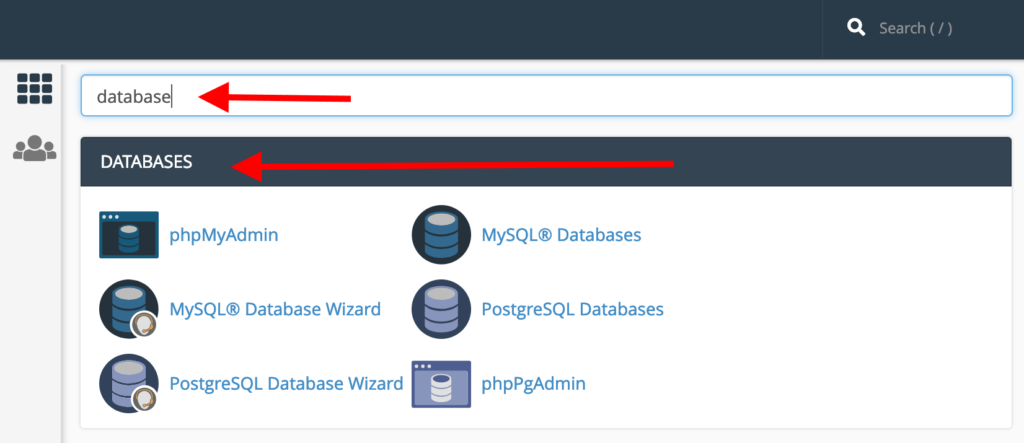
Sidebar
On the left side of your screen, you’ll see a sidebar with a couple of icons – the exact number depends on what your host makes available for you. In our case, from the top down, these stand for Home, Statistics, Dashboard, and User Management.
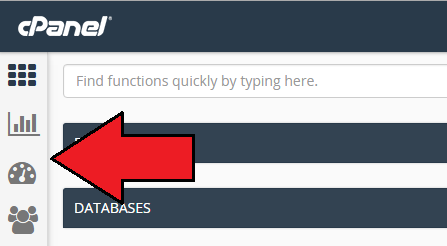
Home is the primary page of cPanel where you can access most of the functions.
Statistics show you a range of important numbers – how many email accounts, file transfer protocol (FTP) accounts, and domain names you have, as well as how much bandwidth and disk space you’re using.
The dashboard is a quick reference page where you’ll find links to some of the most commonly used links, as well as at-a-glance look at your bandwidth and disk space usage, mail statistics, and more.
User Management is where you can add or remove users from your cPanel account. You can also see which email accounts you’ve set up, as well as who has access to your FTP and web disk in case you’re sharing an account with other users or admins.
1.3. Reorganizing cPanel’s Homepage
You can collapse sections by clicking on the “-” sign in the top right corner of each homepage section to minimize it.

If you like to, you can also drag and drop entire sections to reorganize them and put the most commonly used ones near the top.
When you first log in to cPanel, make sure you visit the “PREFERENCES” section to update your contact information and change your password.

Here’s how to do this step by step:
2.1. Changing Your Password
We strongly recommend changing your password as soon as you log in to cPanel for the first time.
Click on “Password & Security”. You’ll be taken to this screen:
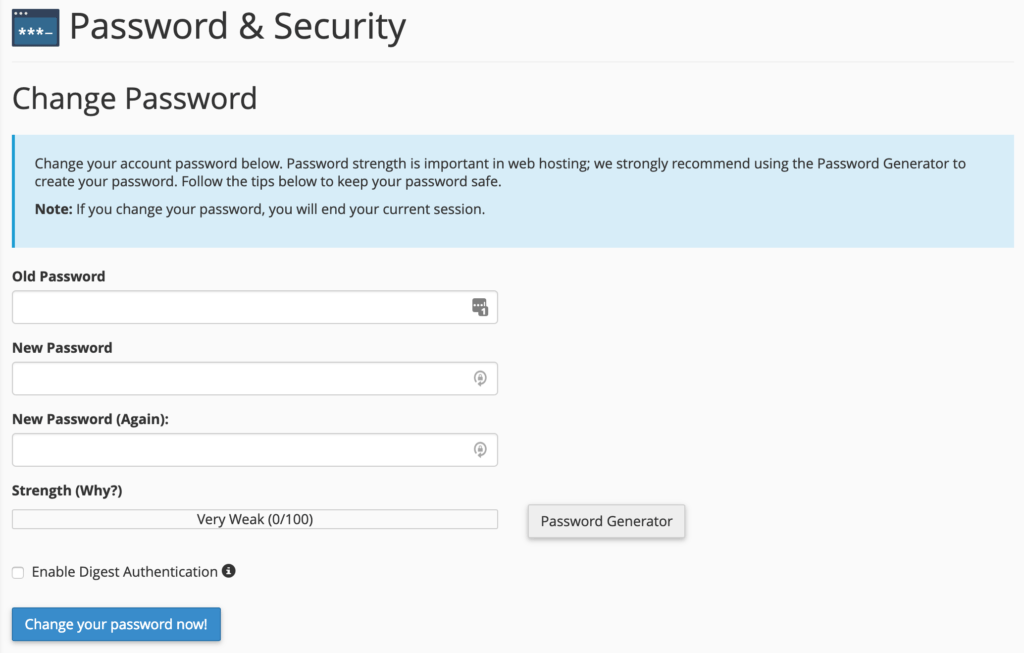
You’ll have to enter your old password before choosing a new one.
When it comes to setting up a new password, you can either take advantage of the Password Generator or come up with something on your own. Using the Password Generator is likely the right way to go, as it will give you a strong and secure password. Just click the button and let the generator take care of the rest:
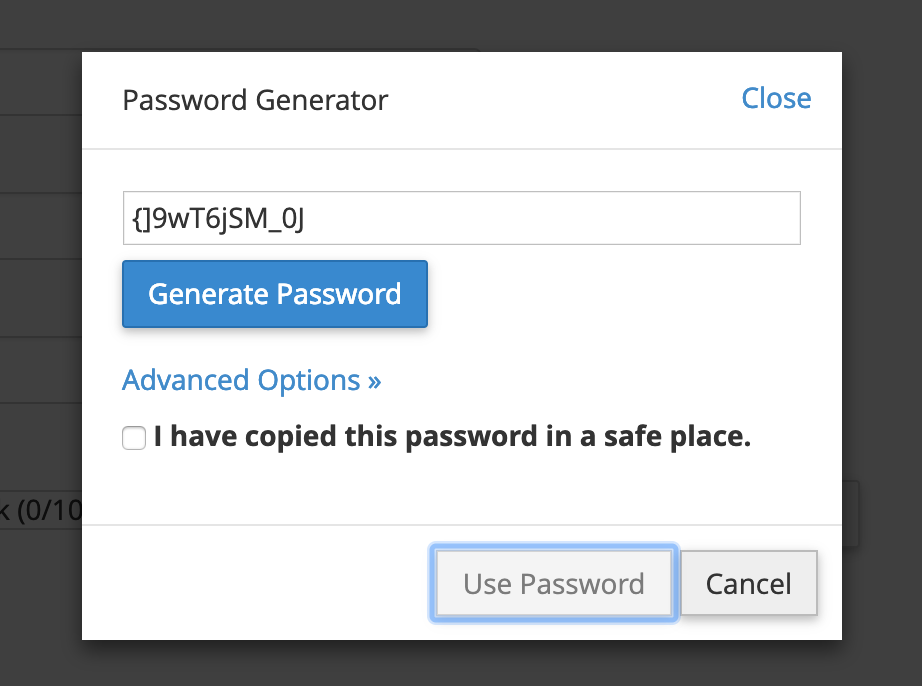
The best way to save that password is to use a password manager. That way, you don’t have to memorize the password. No matter what you do, don’t save your password in a Word file or something similar on your computer – where it could be easily discovered.
2.2. Updating Your Contact Information
One of the most important things you must do in cPanel is to provide an email where you can receive updates when needed.
Why this step is crucial:
- Without a working email set in this section, cPanel won’t be able to communicate with you should anything significant happen with your configuration.
- You also must set the email address to one that’s not attached to any domain name that you’re hosting in this cPanel; otherwise, in case anything happens with your config, that domain might get compromised as well, hence making any attempt at communicating with you impossible.
To get to these settings, click on “Contact Information” to reach the following screen:
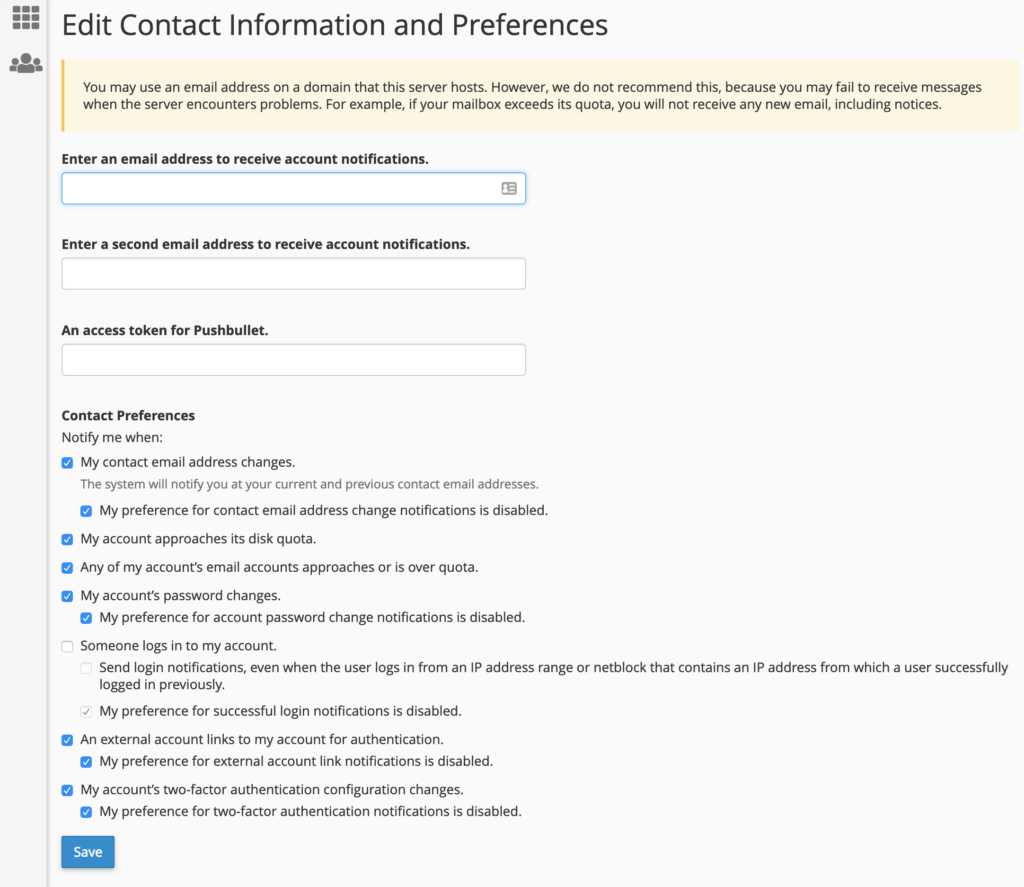
We recommend having all the boxes under “Contact Preferences” checked, as they’re all updates that could alert you to suspicious activities (e.g someone else changing your password) or a hosting problem (e.g disk space being used up).
2.3. Adding a New User
Let’s say you want to... LEARN MORE
The “DOMAINS” section of cPanel is your go-to place when you want to add a new domain name (the one you’ve just purchased) to your hosting account, manage your existing domains, as well as set up subdomains.

3.1. Adding a New Domain Name
To add a domain name to your cPanel (and thus, your hosting package), you’ll need to click on “Addon Domains” in the “DOMAINS” section shown above.
An addon domain is a fancy name for a standard domain name that you can use to create a fully-functional website – meaning you can host multiple domain names from the same control panel.
On the “Addon Domains” screen, you’ll be asked to enter your new domain name plus a couple of other parameters:
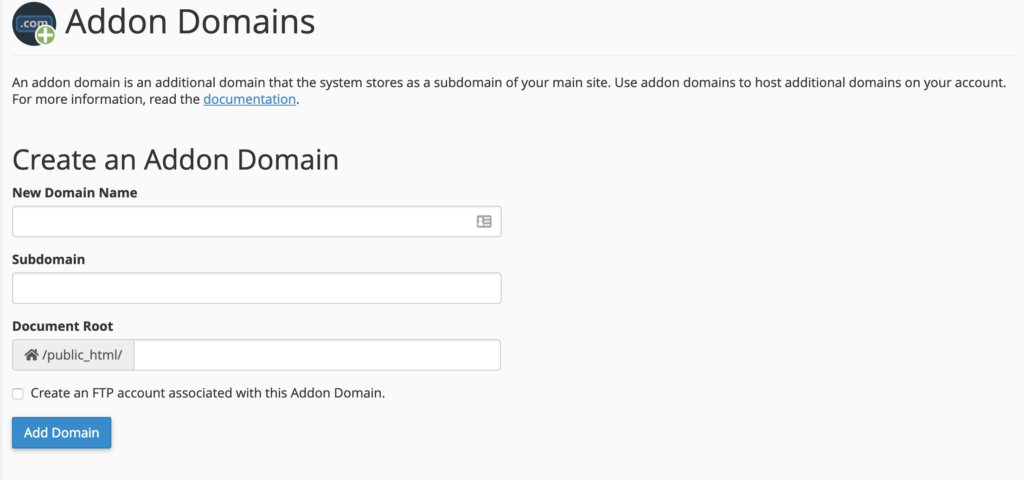
- New Domain Name – The exact domain name that you’ve registered – minus the www. part.
- Subdomain – This will be filled out automatically as soon as you enter your new domain name into the field above. It’s best to leave that intact. cPanel uses this for some internal routing that doesn’t have much relevance from a user point of view.
- Document Root – The location on the server where your new domain’s files will be. This is also filled out automatically. It’s best to stick with these recommended settings.
Click on “Add Domain” to finish up.
3.2. Editing/Removing a Domain Name
On that same “Addon Domains” screen, there’s a section called “Modify Addon Domain” where you can take care of any domains currently assigned to your account – this includes managing them, setting redirections, or removing domains completely.

The usage here is straightforward. There are links for removing and managing the redirections on the right. Clicking on any of them will show you another settings panel where you can confirm the deletion or enter the destination that you want to redirect the domain to.
3.3. Managing Subdomains
Every time you add a new domain to your account (covered above), cPanel will also create a corresponding subdomain to go alongside. Here’s how that usually works, based on an example:
Let’s say your cPanel account name is sam and the host is called greathost.com In that case, your primary server domain is going to be sam.greathost.com. Once you add a new addon domain, say, samsworld.com , cPanel will also create a subdomain called samsworld.sam.greathost.com.
Now, what’s unfortunate about such a setup is that this new subdomain often holds a carbon copy of your normal website that’s available under samsworld.com. In other words, you get the same website available twice, under two addresses: samsworld.com and samsworld.sam.greathost.com.
This is not ideal from an SEO point of view. To fix that, what you should do is redirect that new subdomain to your standard domain. To say it another way, after doing that, whoever tries to go to samsworld.sam.greathost.com will be automatically redirected to samsworld.com.
Here’s how to do that:
First, click on “Subdomains” from... LEARN MORE
One of the great things about keeping your domain name with a cPanel-enabled web host is that you also get the possibility to create custom email accounts for that domain.
This all happens in the “EMAIL” section of cPanel.
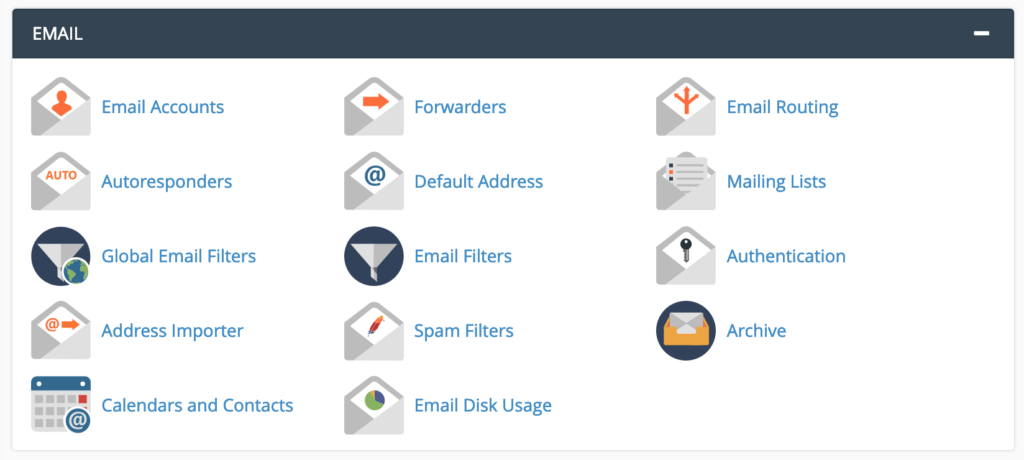
As you can see, there’s plenty of tools there – from creating new emails, setting forwarders, autoresponders, taking care of spam, and more.
4.1. Setting Up an Email Account
Naturally, this is the first thing you will want to do. To add a new email account to your domain, click on “Email Accounts” to be taken to the following screen (make sure you’re on the first tab – “Add Email Account”):
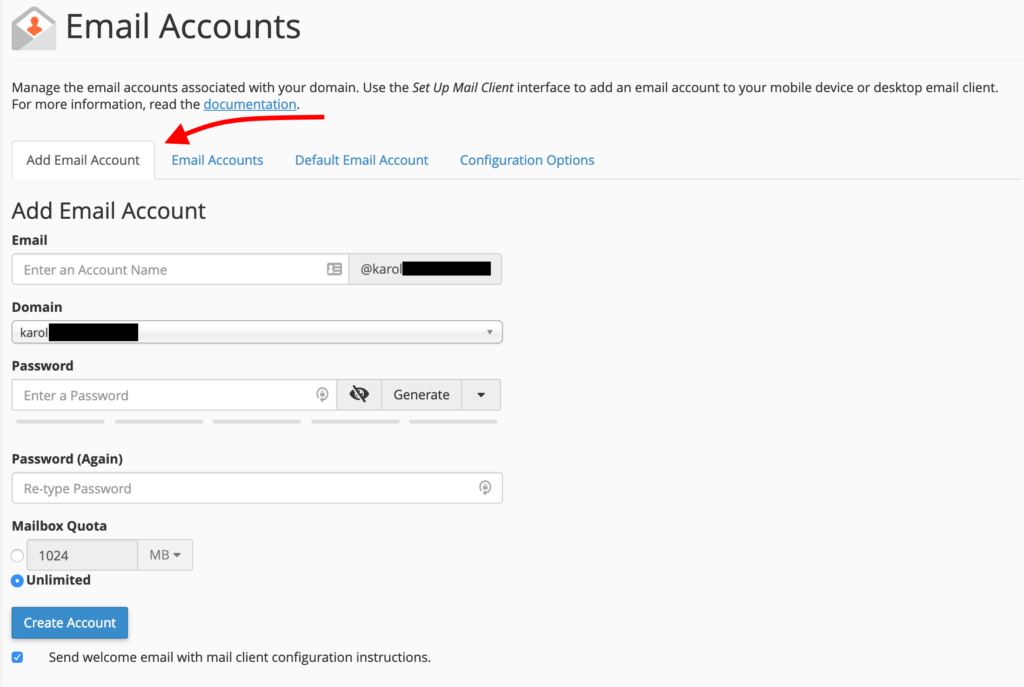
From top to bottom, here’s how to get your new account set up:
• In Email, enter the address you’d like to be reached at – for example, hello or yourname
• In Domain, select the proper domain name from the drop-down field. If you haven’t added your domain name to cPanel yet, you’ll need to do that first.
• In Password, create a password and make sure it’s a secure one!
• In Mailbox Quota, adjust to make sure your email can work properly. Remember: emails take up space on your server, so you may not want to give everyone unlimited access. However, 1GB (=1024MB) is a reasonable minimum.
• Click on “Create Account”
Once you’ve done all of the above, you’ll notice that the email you just created has been added to the list of the existing email accounts in the “Email Accounts” tab:

You can manage every element of that account later on – including the password, quota, and other details.
4.2. Using Your Email
Now that you’ve set up an email account – how do you use it?
You have two main options here:
• Configure the email in an email client – like Gmail, Apple Mail, Outlook, etc.
• Use webmail
Let’s start with the former:
How to Configure Your Email Locally
This step starts a bit counterintuitive, but bear with us. So, to actually configure your email locally, you first need to click on the “Access Webmail” link that’s visible next to your address in the “Email Accounts” tab:

This will take you to a new panel. Once there, scroll down to the section labeled “Mail Client Automatic Configuration Scripts”. You’ll see something like this:

There’s a range of useful links there, all of them with either instructions or ready-made configuration scripts for some of the most popular email clients. If yours is on the list, just click on the link next to it and finish the configuration according to the advice given.
If you can’t see your client, or you want to configure your email manually, then below this section is another one labeled “Mail Client Manual Settings”.
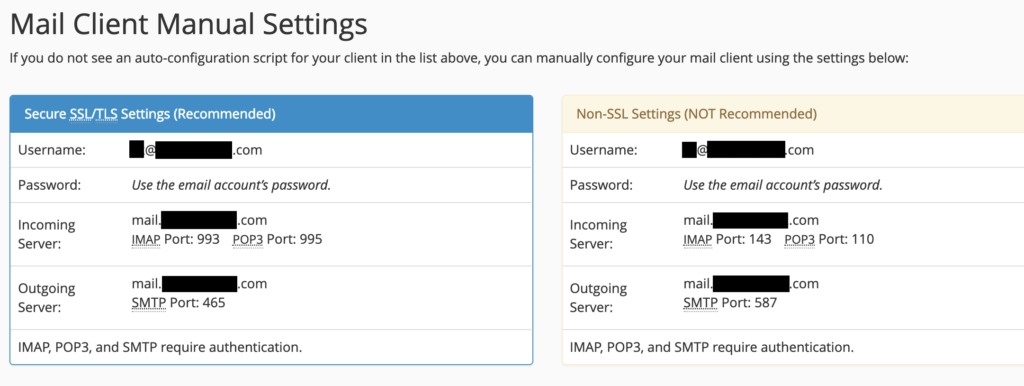
You’ll find all the info you need there.
Accessing Your Webmail
At this point, accessing your webmail is very easy. Click on the “Access Webmail” link that’s visible next to your address in the “Email Accounts” tab:

Once there, click on one of the available webmail clients:
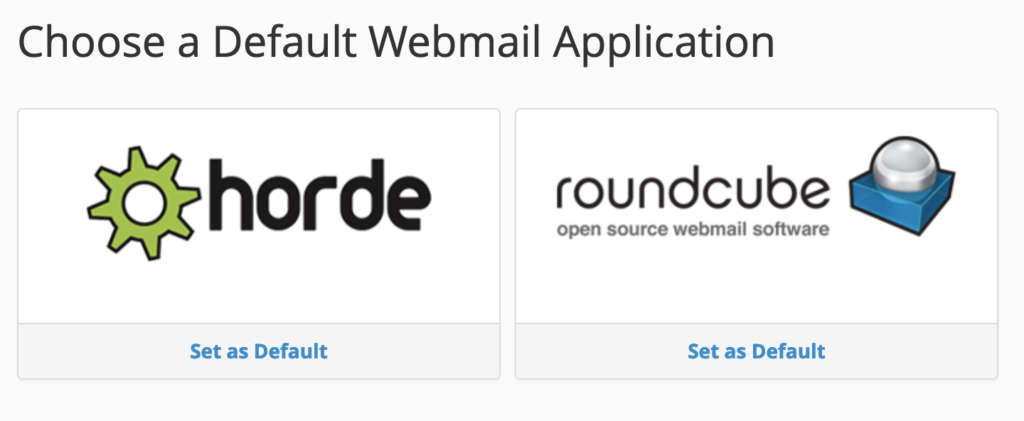
You’ll be taken to your email inbox immediately.
Alternatively, you can access your webmail straight from a web browser. Simply navigate to https://YOURDOMAIN.com/webmail and you’ll be greeted by this screen:
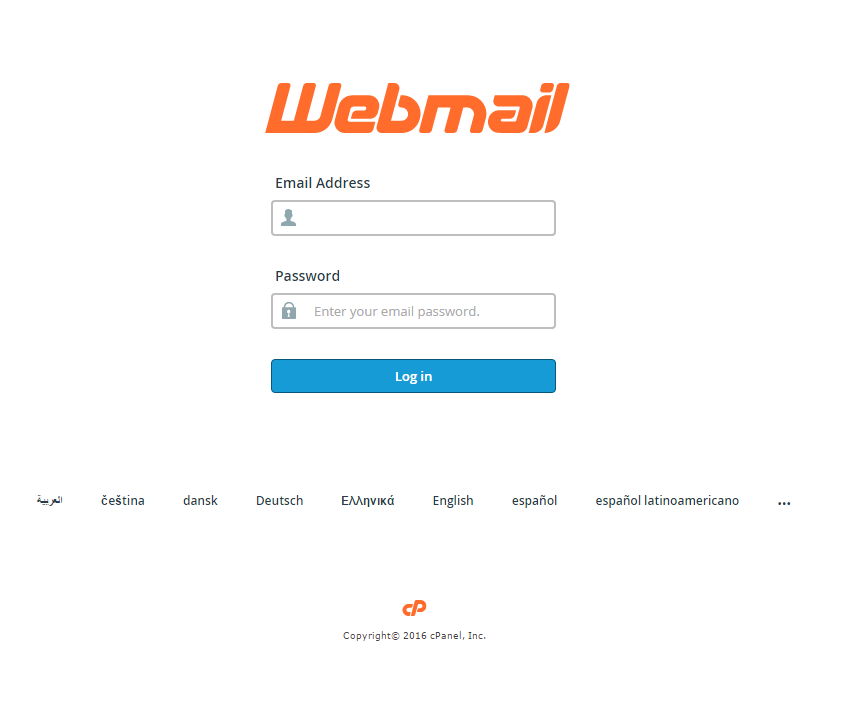
Enter the email address and password, and you’re in.
4.3. Forwarding Your Email to Another Address
Let’s say you want to have your emails that arrive at YOUREMAIL@YOURDOMAIN.com to be forwarded to another address you already own – like YOUREMAIL@gmail.com.
First... LEARN MORE
The “FILES” section of cPanel is your go-to spot for uploading files, backing up your website, and managing your files via FTP *.
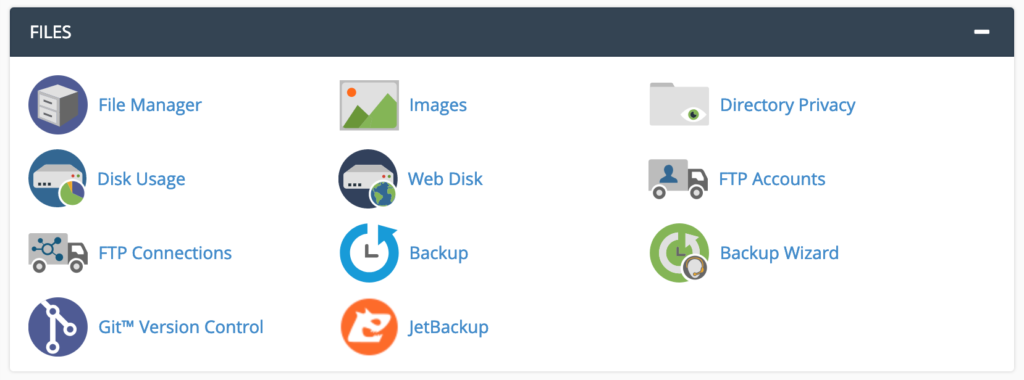
* FTP stands for File Transfer Protocol. You can use FTP to manage the files associated with your website – whether that means uploading, reading, or retrieving them. All you need to use FTP is a client application such as FileZilla. Alternatively, cPanel also provides you with tools to manage your files without an FTP tool. We’ll cover that next.
5.1. Using the File Manager
The first space you’ll want to get acquainted with within the “FILES” section is the “File Manager”.
The “File Manager” allows you to manage all of your sites’ files directly from within the cPanel interface rather than having to use a third-party FTP tool.
Click on the “File Manager” icon (visible in the screenshot above) to begin. What you’ll see is the central panel of the “File Manager”. It’ll look something like this:
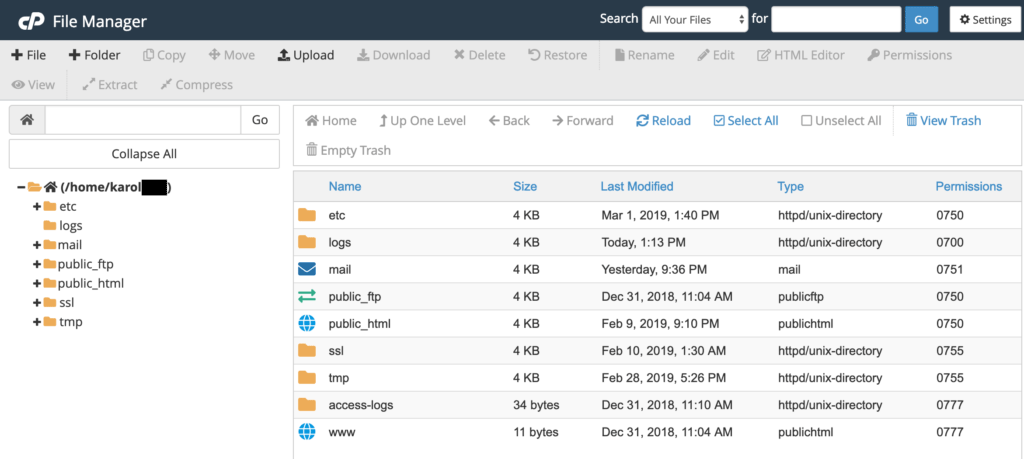
This is where you can take care of all the files on your server, therefore you’ll want to proceed with extreme caution when making any changes.
There are a couple of quick things to point out on this screen. First, on the left, you’ll find your root (main) folder and some sub-folders (you can see this in the screenshot above).
Then, in the middle of the screen, you’ll see the contents of whatever folder you have selected.
Knowing this, here are a few things you might want to do:
Create a New Folder
To create a new folder, simply click on the “+ Folder” button along with the top menu, as shown below:

You’ll then be asked to name your new folder and enter the destination where the folder will be created.
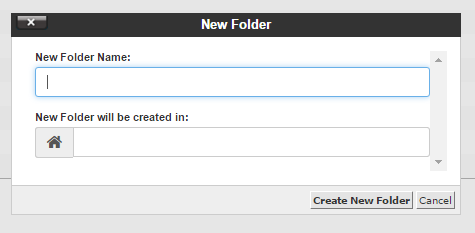
When you’re done, click on “Create New Folder”, and you’re set.
Uploading a File Using File Manager
To add a file – for example, a large video file that you want people to be able to download, or a full-quality photo you want to use on your site – you’ll first need to click on the folder where you want to upload the file to.
Then, just click on the “Upload” button that’s in the top menu:

You’ll be asked to drag and drop the file you want to upload, or simply select the file from your local drive:
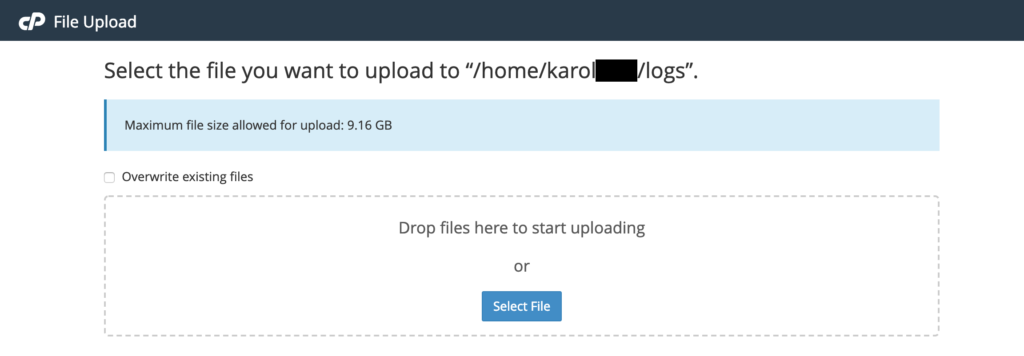
Note; If your website software allows you to upload files from its user interface, do that instead of going to the File Manager in cPanel. Since you’re going to be using those files on your site anyway, it’s just easier to manage things that way – your website software will “see” the file immediately. If you upload a file via the File Manager or FTP, that might not be the case. WordPress works really well with files.
5.2. Access Your Main FTP Account
Depending on how your web host has set up your cPanel account, you might be able to log in to your main FTP account using the same cPanel login and pass.
To check if that’s the case, click on “FTP Accounts” from the “FILES” section. Once there, scroll down to “Special FTP Accounts”. Your main FTP account should be there.

By default, the main FTP account will have access to the root folder.
5.3. Adding a New FTP Account
Creating new FTP accounts is a good practice when working with cPanel and launching new projects/websites on your hosting setup.
Having one account per project is a good starting point. The idea is that you give those individual accounts only access to the specific folder they need access to – not to the whole web server.
To create new FTP accounts, click on “FTP Accounts” form the “FILES” section. You’ll see this screen:
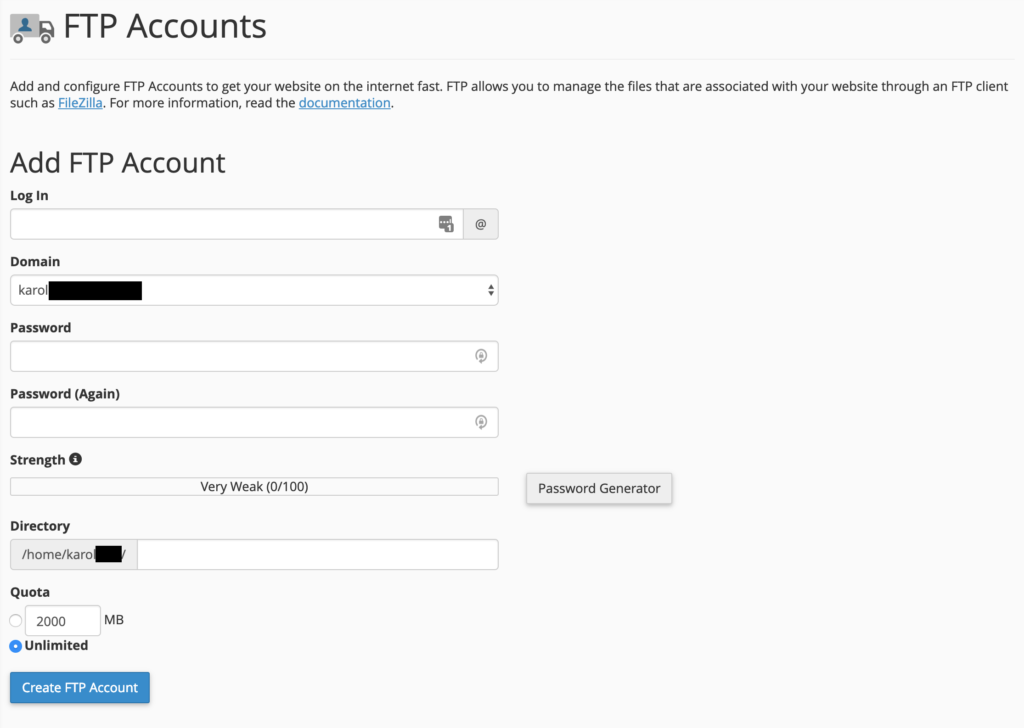
Here’s how to fill out that form and create a new account:
• Log In – This is the username of the new account.
• Domain –The domain name that the new user account will be assigned to. Pick from the drop-down.
• Directory – This defines the new FTP account’s highest level of directory access. If you leave this blank, the user will have access to the root. It’s best to input the directory associated with the project that the account is for.
• Quota – The maximum space that the new user can take up. Best leave at “Unlimited”.
Once you click on “Create FTP Account”, the new user will be added.
You can manage your existing FTP accounts on the same page, below the new user form:

Most modern websites cannot exist without a database running quietly behind the curtains and handling the website’s data.
In other words, all of your website’s content, all the pages, all the posts, and all the user data is kept in the database.
As you would expect by now, cPanel has a pretty extensive module allowing you to create and manage databases.
6.1. Creating a Database
If you want to set up any modern website using a CMS, you’ll need to create a database for it first.
The “DATABASES” section of cPanel has a handful of options available:

Most importantly, cPanel allows you to work with both MySQL and PostgreSQL databases. For the purpose of this guide, we’ll stick to MySQL, but working with PostgreSQL is nearly the same.
To create a new database, click on “MySQL Database Wizard” in the “DATABASES” section (see above).
Once there, you can start setting up your new database.
Step 1. Set a name for your database:
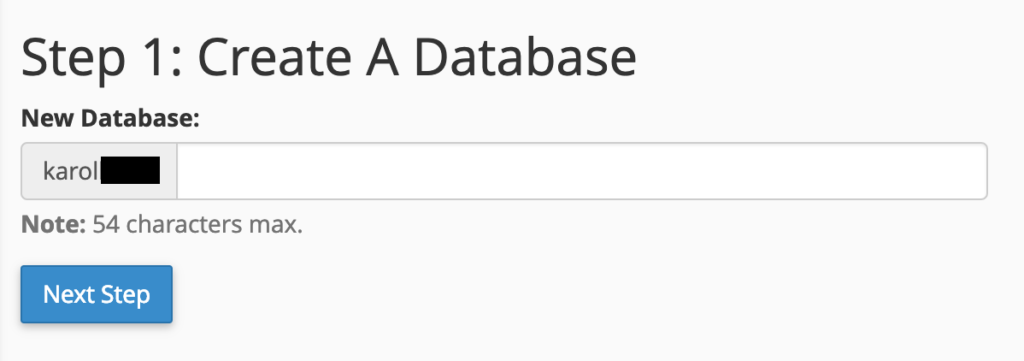
Step 2. Create a database user that will be used to access the database (this is required in order to work with the database later on):
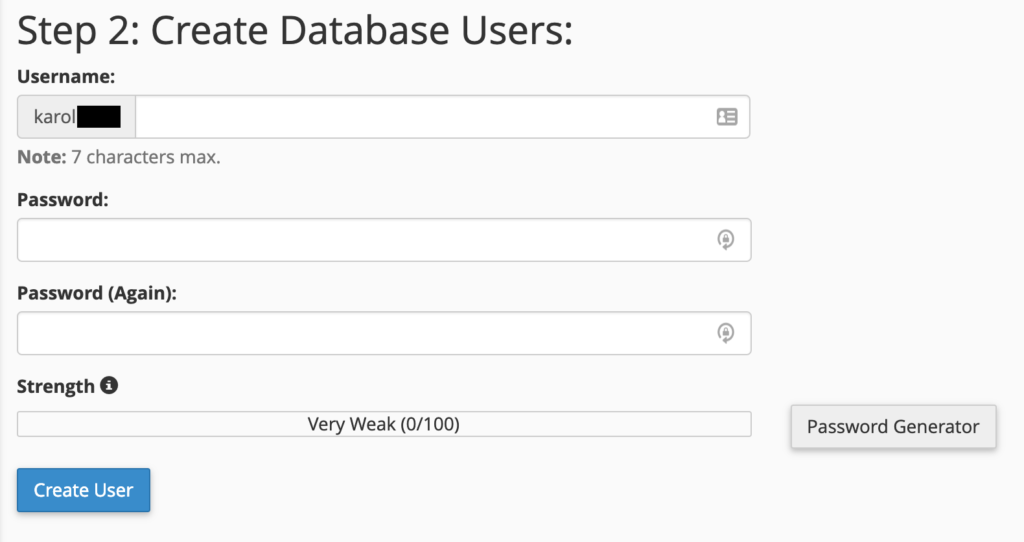
Step 3. Assign the required privileges to that new database user; it’s best to select the option labeled “ALL PRIVILEGES”, like so:
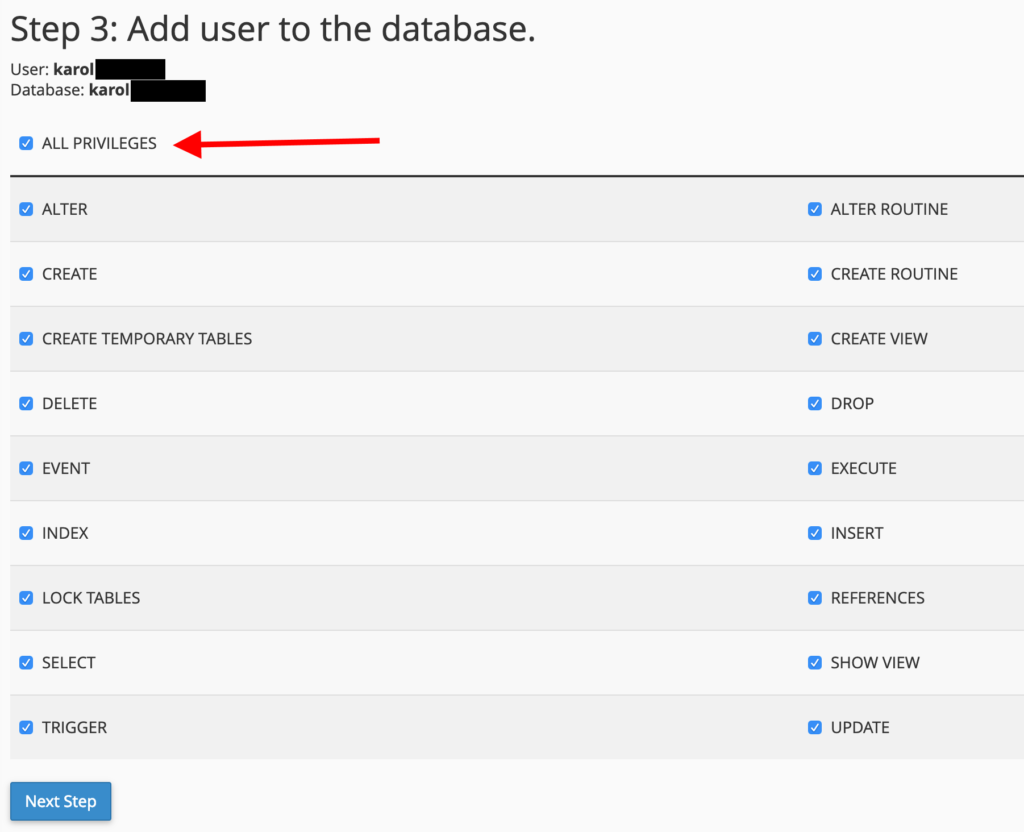
Step 4. Done.
At this stage, your new database has been set.
To see it, go back to the main page of cPanel and click on “MySQL Databases”.
6.2. Managing Databases
To see all your databases, go to “MySQL Databases” from the “DATABASES” section of cPanel.

Each database can be renamed or deleted through the links to the right.
Additionally, you can also manage your database users there, a bit further down the page.

The final thing that’s worth a look at as you’re going through cPanel is the section labeled “METRICS”.

You can find a lot of interesting details there, all informing you about the current status of your server, the number of visits you’re getting, and the overall health of the setup.
Each of these stats sections presents a slightly different take on your numbers:
• Visitors, Raw Access, Awstats, Webalizer all focus on the number of visitors your websites have been getting. The presentation varies between each of these sub-sections.
• Errors present the most recent entries in your website’s error logs.
• Bandwidth allows you to see the bandwidth usage of your hosting setup.
• Webalizer FTP show you data on all visits through the FTP protocol.
• CPU and Concurrent Connection Usage shows you the volume of machine resources consumed by your hosting setup.